
The Romanian Naval Forces is the principal naval branch of the Romanian Armed Forces and operates in the Black Sea and on the Danube. It traces its history back to 1860.

The M-class submarines, also Malyutka class, were a class of small, single-, or 1½-hulled coastal submarines built in the Soviet Union and used during World War II. The submarines were built in sections so they could easily be transported by rail. The production was centered in the Gorky Shipyard on the Volga River, after which the sections were transported by railway to Leningrad for assembly and fitting out. This was the first use of welding on Soviet submarines.
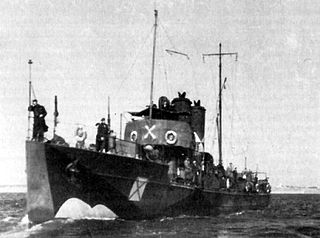
NMS Smeul was a torpedo boat of the Royal Romanian Navy. She was commissioned in 1920, after initially serving as Tb 83 F in the Austro-Hungarian Navy during World War I. She and six more sister ships were awarded to Romania as reparations after the war ended.

The Shchuka-class submarines, also referred to as Sh or Shch-class submarines, were a medium-sized class of Soviet submarines, built in large numbers and used during World War II. "Shchuka" is Russian for pike. Of this class, only two submarines entered service after 1945, although they were launched before the war.
The Black Sea Campaigns were the operations of the Axis and Soviet naval forces in the Black Sea and its coastal regions during World War II between 1941 and 1944, including in support of the land forces.
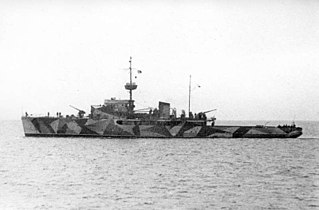
NMS Amiral Murgescu was a minelayer and convoy escort of the Romanian Navy, the first sea-going warship built in Romania and the largest Romanian-built warship of World War II. She laid numerous minefields, from the Bulgarian port of Burgas to the Crimean port of Sevastopol, which inflicted significant losses to the Soviet Black Sea Fleet. She also carried out numerous convoy escort missions and took part in the Axis evacuation of the Crimea in May 1944. Due to her success in combat, she was decorated twice by May 1944. She was captured by the Soviet Union in September 1944 and served until 1988, when she was scrapped.

The Raid on Constanța was an attack by the Soviet Black Sea Fleet on the Romanian port of Constanța on 26 June 1941, shortly after the beginning of Operation Barbarossa, the Axis invasion of the Soviet Union, and resulted in the only encounter between major warships in the Black Sea during World War II. The attack was intended to be a coordinated effort between the fleet's ships and aircraft to split the attention of the defenders, but the bombers did not attack at the designated times.

Submarine warfare in the Black Sea in World War II during 1941 primarily involved engagements between submarines of the Soviet Black Sea Fleet attacking Axis merchantmen defended by Romanian and Bulgarian warships. These engagements were a part of the naval Black Sea campaigns between Axis and Soviet naval forces.
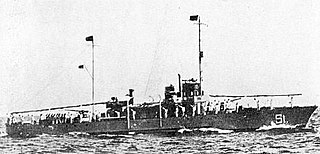
The Battle of Cape Burnas was a naval engagement between the Soviet and Romanian navies near the Burnas Lagoon in October 1942.

Italian submarine Beilul was an Adua-class submarine built for the Royal Italian Navy during the 1930s. It was named after a town of Beilul in Eritrea.
The Romanian Navy during World War II was the main Axis naval force in the Black Sea campaigns and fought against the Soviet Union's Black Sea Fleet from 1941 to 1944. Operations consisted mainly of mine warfare, but there were also escort missions and localized naval engagements. The largest naval action fought by the Romanian Navy was the 26 June 1941 Raid on Constanța, and its most extensive operation was the 1944 evacuation of the Crimea.
The action of 6 December 1941 was a confrontation between the Bulgarian and Soviet navies in the Black Sea during World War II, taking place near the Bulgarian coast at Cape Emine.
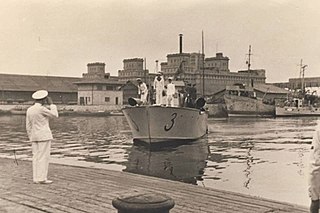
NMS Viscolul was the most successful and the longest-serving motor torpedo boat of the Romanian Navy during the Second World War. She supported the Siege of Odessa and took part in the action of 9 July 1941.

NMS Sublocotenent Ghiculescu was a specialized ASW gunboat of the Romanian Navy. Initially built as a French warship in late World War I, she was purchased by Romania in 1920 and fought during World War II, sinking two submarines and one motor torpedo boat. After 1 year of Soviet service, she was returned to Romania and served as a survey vessel until 2002.

The Soviet Black Sea Fleet during the first years of the Black Sea campaigns (1941–44) conducted raiding operations along the Western coast of the Black Sea aimed to disrupt Axis communications and supplies by sea.
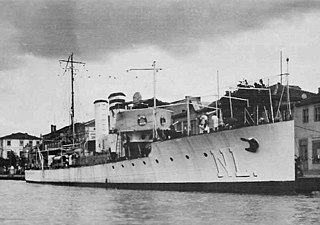
NMS Năluca was a torpedo boat of the Royal Romanian Navy. She was commissioned in 1920, after initially serving as Tb 82 F in the Austro-Hungarian Navy during World War I. She and six more sister ships were awarded to Romania as reparations after the war ended.

Turbine was the lead ship of her class of eight destroyers built for the Regia Marina during the 1920s. Her name means whirlwind.
Submarine warfare in the Black Sea in World War II during 1942 involved engagements between primarily submarines of the Soviet Black Sea Fleet attacking Axis merchantmen defended by Romanian and German naval warships. These engagements were a part of the Black Sea campaigns between Axis and Soviet naval forces.

Between 1941 and 1944, Romania held control over much of the Ukrainian Black Sea coast East of the Crimea. This was acquired during Operation Barbarossa. The Romanian conquest of the Soviet Western Black Sea coast started in July 1941 during Operation München and ended in October that year, after the Siege of Odessa. In the aftermath of these actions, Romania (re)acquired two new sectors of coastline: the Bessarabian coast and the Transnistrian Coast. The latter was lost in April 1944, but the former was successfully defended until August 1944.

NMS Regele Carol I was a passenger ship of the Romanian Maritime Service and later a warship of the Romanian Navy, serving as both minelayer and seaplane tender. She was completed and commissioned in 1898 and sunk in 1941, during World War II.

















